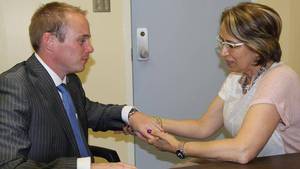Don Locke remembers the life-changing moment. It was 1971 and he was four years old, living in his home province of Newfoundland. During an informal game of soccer, the ball was accidentally kicked under the fence of a nearby electrical substation.
Don was an intrepid young man and crawled under the fence to retrieve it, innocent of the dangers surrounding him on all sides. One step took him too close to a bare transformer, which yanked him toward it and charged his body with 8,900 volts of electricity. He was thrown against the fence he’d just overcome, feeling as though he had died.
“I remember it like it happened yesterday,” said Don, now 49 and living in Middle Sackville.
He was rushed to hospital where physicians induced a month-long coma, interrupted only once by his parents two weeks in. They were tasked with telling him his left hand and foot would have to be amputated. Don, being left-handed, asked who would be responsible for filling in his colouring books after the surgery, demonstrating his priorities and his courage as only four-year-olds can.
Don suffered from hemophilia, preventing his blood from clotting and making a bad situation worse. Removing his hand and foot wasn’t enough to stabilize his wounded limbs, so progressively more was removed until his arm extended just below the elbow, and his leg just below the knee. After a year and a half, Don was fitted for prosthetic limbs, taking his first steps in a very long time. Then, as his mother tells it, he began to run.
“I don’t consider myself an amputee because I don’t really miss my limbs,” said Don. “I have to wear a leg in order to walk but it’s a part of me now.”
It was Don’s mother who first encouraged him to work with prosthetics and his fellow amputees, but for a long time he refused for lack of interest. That began to change in the early 1980s when he joined the Paralympics, an athletic organization which allowed him to train and compete in javelin, shot-put, the 100 metre freestyle and the 50 metre breast stroke, alongside people with disabilities of their own. He originally became involved for the opportunity to get fit, but was soon inspired by the courage and resilience he saw all around him. After a decade of competing, Don finally embraced his mother’s advice.
In 1998 he became a registered prosthetics technician, joining the staff of the QEII’s Nova Scotia Rehabilitation and Arthritis Centre the following year. He’s gone from using prosthetics to building them, customizing them for the thousands of lifestyles and body types under the centre’s care.
His days are spent in a workshop of sorts, using his right arm and what remains of his left to give people back their lives. But his contributions to the centre go beyond the crafting of prosthetics. He also works directly with amputees; people who have recently lost limbs to injury, disease or birth defects. Don is able to offer them something many of his colleagues simply can’t — personal experience.
“To some people, losing a limb is very traumatic,” said Don. “Being an amputee isn’t something you figure out overnight. If you’ve had your arms and legs your whole life then all of a sudden you’re missing one, you think life is over. I’m here to show them that, not only is life not over, it can get better. You can be whatever you want to be. This is just a change, not an end.”
Don is one of many offering amputees hope. Together, the teams at the QEII’s Rehabilitation Centre ensure anyone who’s lost a limb can get back on their feet, whether those feet are flesh and blood or carbon fibre.
“If I didn’t have the exposure to patients, I don’t think I’d be doing this,” said Don. “I just enjoy helping people so much. It means everything in the world to me.”








